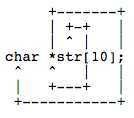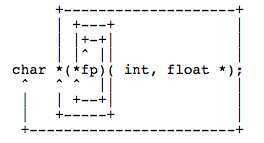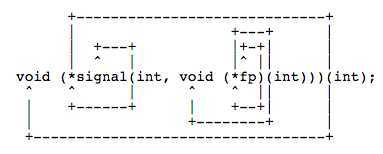标签:
【Clockwise/Spiral Rule】
There is a technique known as the ``Clockwise/Spiral Rule‘‘. (顺时针螺旋法则).
There are three simple steps to follow:
- Starting with the unknown element, move in a spiral/clockwise direction; when ecountering the following elements replace them with the corresponding english statements:
- [X] or []
- => Array X size of... or Array undefined size of...
- (type1, type2)
- => function passing type1 and type2 returning...
- *
- => pointer(s) to...
- Keep doing this in a spiral/clockwise direction until all tokens have been covered.
- Always resolve anything in parenthesis first!
Example #1: Simple declaration

Question we ask ourselves: What is str?
``str is an...
- We move in a spiral clockwise direction starting with `str‘ and the first character we see is a `[‘ so, that means we have an array, so...
``str is an array 10 of...
- Continue in a spiral clockwise direction, and the next thing we encounter is the `*‘ so, that means we have pointers, so...
``str is an array 10 of pointers to...
- Continue in a spiral direction and we see the end of the line (the `;‘), so keep going and we get to the type `char‘, so...
``str is an array 10 of pointers to char‘‘
- We have now ``visited‘‘ every token; therefore we are done!
Example #2: Pointer to Function declaration

Question we ask ourselves: What is fp?
``fp is a...
- Moving in a spiral clockwise direction, the first thing we see is a `)‘; therefore, fp is inside parenthesis, so we continue the spiral inside the parenthesis and the next character seen is the `*‘, so...
``fp is a pointer to...
- We are now out of the parenthesis and continuing in a spiral clockwise direction, we see the `(‘; therefore, we have a function, so...
``fp is a pointer to a function passing an int and a pointer to float returning...
- Continuing in a spiral fashion, we then see the `*‘ character, so...
``fp is a pointer to a function passing an int and a pointer to float returning a pointer to...
- Continuing in a spiral fashion we see the `;‘, but we haven‘t visited all tokens, so we continue and finally get to the type `char‘, so...
``fp is a pointer to a function passing an int and a pointer to float returning a pointer to a char‘‘
Example #3: The ``Ultimate‘‘

Question we ask ourselves: What is `signal‘?
Notice that signal is inside parenthesis, so we must resolve this first!
- Moving in a clockwise direction we see `(‘ so we have...
``signal is a function passing an int and a...
- Hmmm, we can use this same rule on `fp‘, so... What is fp? fp is also inside parenthesis so continuing we see an `*‘, so...
fp is a pointer to...
- Continue in a spiral clockwise direction and we get to `(‘, so...
``fp is a pointer to a function passing int returning...‘‘
- Now we continue out of the function parenthesis and we see void, so...
``fp is a pointer to a function passing int returning nothing (void)‘‘
- We have finished with fp so let‘s catch up with `signal‘, we now have...
``signal is a function passing an int and a pointer to a function passing an int returning nothing (void) returning...
- We are still inside parenthesis so the next character seen is a `*‘, so...
``signal is a function passing an int and a pointer to a function passing an int returning nothing (void) returning a pointer to...
- We have now resolved the items within parenthesis, so continuing clockwise, we then see another `(‘, so...
``signal is a function passing an int and a pointer to a function passing an int returning nothing (void) returning a pointer to a function passing an int returning...
- Finally we continue and the only thing left is the word `void‘, so the final complete definition for signal is:
``signal is a function passing an int and a pointer to a function passing an int returning nothing (void) returning a pointer to a function passing an int returning nothing (void)‘‘
The same rule is applied for const and volatile. For Example:
const char *chptr;
- Now, what is chptr??
``chptr is a pointer to a char constant‘‘
How about this one:
char * const chptr;
- Now, what is chptr??
``chptr is a constant pointer to char‘‘
Finally:
volatile char * const chptr;
- Now, what is chptr??
``chptr is a constant pointer to a char volatile.‘‘
参考:http://c-faq.com/decl/spiral.anderson.html
Clockwise/Spiral Rule
标签:
原文地址:http://www.cnblogs.com/tekkaman/p/4253901.html


